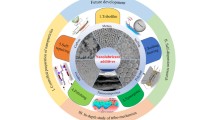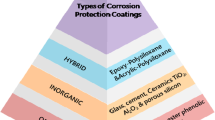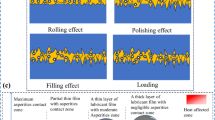Abstract
Isolation and characterization of metal-on-metal (MoM) wear particles from simulator lubricants is essential to understand wear behaviour, ion release and associated corrosive activity related to the wear particles. Substantial challenges remain to establish a simple, precise and repeatable protocol for the isolation and analysis of wear particles due to their extremely small size, their tendency to agglomerate and degrade. In this paper, we describe a simple and efficient method for the bulk isolation and characterisation of wear particles from MoM bearings. Freeze drying was used to remove the large volume of water from the serum lubricant, enzymes used to digest the proteins and ultracentrifugation to finally isolate and purify the particles. The present study involved a total of eight steps for the isolation process and a wear particle extraction efficiency of 45% was achieved.







Similar content being viewed by others
References
Dowson D, Hardaker C, Flett M, Isaac GH. A hip joint simulator study of the performance of metal-on-metal joints-Part I: the role of materials. J Arthroplast. 2004;19:118–23.
Bowsher JG, Nevelos J, Williams PA, Shelton JC. ‘Severe’ wear challenge to ‘as-cast’ and ‘double heat-treated’ large-diameter metal-on-metal hip bearings. Proc Inst Mech Eng [H]. 2006;220:135–43.
Leslie IJ, Williams S, Brown C, Anderson J, Isaac G, Hatto P, Ingham E, Fisher J. Surface engineering: a low wearing solution for metal-on-metal hip surface replacements. J Biomed Mater Res [B]. 2009;90B:558–65.
Bowsher JG, Hussain A, Williams PA, Shelton JC. Metal-on-metal hip simulator study of increased wear particle surface area due to ‘severe’ patient activity. Proc Inst Mech Eng [H]. 2006;220:279–87.
Catelas I, Medley JB, Campbell PA, Huk OL, Bobyn JD. Comparison of in vitro with in vivo characteristics of wear particles from metal–metal hip implants. J Biomed Mater Res [B]. 2004;70B:167–78.
Milosev I, Remskar M. In vivo production of nanosized metal wear debris formed by tribochemical reaction as confirmed by high-resolution TEM and XPS analyses. J Biomed Mater Res [A]. 2009;91A:1100–10.
Buscher R, Tager G, Dudzinski W, Gleising B, Wimmer MA, Fischer A. Subsurface microstructure of metal-on-metal hip joints and its relationship to wear particle generation. J Biomed Mater Res [B]. 2005;72B:206–14.
Doorn PF, Campbell PA, Worrall J, Benya PD, McKellop HA, Amstutz HC. Metal wear particle characterization from metal on metal total hip replacements: transmission electron microscopy study of periprosthetic tissues and isolated particles. J Biomed Mater Res. 1998;42:103–11.
Khan M, Kuiper JH, Richardson JB. Can cobalt levels estimate in vivo wear of metal-on-metal bearings used in hip arthroplasty? Proc Inst Mech Eng [H]. 2007;221:929–42.
Urban RM, Jacobs JJ, Tomlinson MJ, Gavrilovic J, Black J, Peoc’h M. Dissemination of wear particles to the liver, spleen, and abdominal lymph nodes of patients with hip or knee replacement. J Bone Joint Surg Am. 2000;82A:457–77.
Willert HG, Buchhorn GH, Fayyazi A, Flury R, Windler M, Koster G, Lohmann CH. Metal-on-metal bearings and hypersensitivity in patients with artificial hip joints: a clinical and histomorphological study. J Bone Joint Surg Am. 2005;87A:28–36.
Park YS, Moon YW, Lim SJ, Yang JM, Ahn GW, Choi YL. Early osteolysis following second-generation metal-on-metal hip replacement. J Bone Joint Surg Am. 2005;87A:1515–21.
Grammatopoulos G, Pandit H, Murray DW, Gill HS. The relationship between head-neck ratio and pseudotumour formation in metal-on-metal resurfacing arthroplasty of the hip. J Bone Joint Surg Br. 2010;92B:1527–34.
Campbell PA, Ma S, Yeom B, McKellop H, Schmalzried TP, Amstutz HC. Isolation of predominantly submicron-sized Uhmwpe wear particles from periprosthetic tissues. J Biomed Mater Res. 1995;29:127–31.
Catelas I, Bobyn JD, Medley JB, Krygier JJ, Zukor DJ, Petit A, Huk OL. Effects of digestion protocols on the isolation and characterization of metal–metal wear particles. I. Analysis of particle size and shape. J Biomed Mater Res. 2001;55:320–9.
Billi F, Benya P, Ebramzadeh E, Campbell P, Chan F, Mckellop HA. Metal wear particles: what we know, what we do not know, and why. SAS J. 2009;3:133–42.
Catelas I, Bobyn JD, Medley JB, Krygier JJ, Zukor DJ, Huk OL. Size, shape, and composition of wear particles from metal–metal hip simulator testing: effects of alloy and number of loading cycles. J Biomed Mater Res [A]. 2003;67A:312–27.
Brown C, Williams S, Tipper JL, Fisher J, Ingham E. Characterisation of wear particles produced by metal on metal and ceramic on metal hip prostheses under standard and microseparation simulation. J Mater Sci Mater Med. 2007;18:819–27.
Wick GL, Tooby PF. Centrifugal buoyancy forces. Am J Phys. 1977;45:1074–6.
Yu HB, Qu YL, Dong ZL, Li WJ, Wang YC, Ren WC, Cui ZS (2007) Separation of mixed SWNTs and MWNTs by centrifugal force: an experimental study. 7th IEEE Conference on Nanotechnology 1–3:1223–1227.
Billi F, Benya P, Kavanaugh A, Adams J, McKellop H, Ebramzadeh E (2012) An accurate and extremely sensitive method to separate, display, and characterize wear debris. Part 2: metal and ceramic particles. Clin Orthop Relat Res 470:339–350. doi:10.1007/s11999-011-2058-9
Hart AJ, Quinn PD, Sampon B, Sandison A (2010) The chemical form of metallic debris in tissues surrounding metal-on-metal hips with unexplained failure. Acta Biomater (in press).
Huber M, Reinisch G, Trettenhahn G, Zweymuller K, Lintner F. Presence of corrosion products and hypersensitivity-associated reactions in periprosthetic tissue after aseptic loosening of total hip replacements with metal bearing surfaces. Acta Biomater. 2009;5:172–80.
Jacobs JJ, Urban RM, Hallab NJ, Skipor AK, Fischer A, Wimmer MA. Metal-on-metal bearing surfaces. J Am Acad Orthop Surg. 2009;17:69–76.
Lewis AC, Kilburn MR, Heard PJ, Scott TB, Hallam KR, Allen GC, Learmonth ID. The entrapment of corrosion products from CoCr implant alloys in the deposits of calcium phosphate: a comparison of serum, synovial fluid, albumin, EDTA, and water. J Orthop Res. 2006;24:1587–96.
Rincic N, Baucic I, Miko S, Papic M, Prohic E. Corrosion behaviour of the Co–Cr–Mo dental alloy in solutions of different composition and different pH values. Coll Antropol. 2003;27:99–106.
Abdelwahed W, Degobert G, Stainmesse S, Fessi H. Freeze-drying of nanoparticles: formulation, process and storage considerations. Adv Drug delivery Rev. 2006;58:1688–713.
Acknowledgments
The authors are grateful to Corin, Tecvac, the EPSRC and the TSB for co-funding this work through the UK TSB Project No. TP-Q0033F, ‘SMARTHIP’ and for the invaluable comments from Dr. F. Billi, LAOH, UCLA during the preparation of this manuscript.
Author information
Authors and Affiliations
Corresponding author
Electronic supplementary material
Below is the link to the electronic supplementary material.
Rights and permissions
About this article
Cite this article
Lu, F., Royle, M., Lali, F.V. et al. Simple isolation method for the bulk isolation of wear particles from metal on metal bearing surfaces generated in a hip simulator test. J Mater Sci: Mater Med 23, 891–901 (2012). https://doi.org/10.1007/s10856-012-4573-y
Received:
Accepted:
Published:
Issue Date:
DOI: https://doi.org/10.1007/s10856-012-4573-y




